Preface Welcome back once more! Youve come a long way.
I can see that youre itching to learn more Korean (figuratively, of course hopefully). After completing the first two books, you should now have a strong beginning foundation in the Korean language. But were not going to stop there. Theres still much more that we need to cover.  About this Book While all three books in this series follow the same general format of presenting dialogues with grammar explanations and additional notes, each book offers something unique. The first book, Korean Made Simple, focuses on building the basic foundations to begin studying Korean.
About this Book While all three books in this series follow the same general format of presenting dialogues with grammar explanations and additional notes, each book offers something unique. The first book, Korean Made Simple, focuses on building the basic foundations to begin studying Korean.
Its lessons revolve around common themes and day-to-day situations such as introducing yourself, shopping, and telling the time. The second book, Korean Made Simple 2, is geared toward increasing communication skills and focuses more on grammatical concepts. This third book will concentrate mostly on introducing new grammar and concepts that you will need in real world situations. It is designed to help you reinforce and build upon the foundation started in the previous two books so that you will be able to continue learning the Korean language in your own way. This book will also explain increasingly difficult Korean concepts as simply as possible. Many of the concepts in this book are considered to be intermediate level, and some are even considered advanced, but are all common and necessary to know.
A major difference between this book and the previous books is how the grammar forms and concepts will be taught. In the previous two books, major grammar was taught at the beginning of the chapter before explaining the sample dialogue. That was because each chapter only introduced a small amount of new grammar. This book will introduce a much larger amount of grammar in each chapter, so new grammar will be divided and taught while examining the dialogue. I would recommend reading the dialogues again after having finished each chapter, before moving on to the next one. Since this book will continue directly where Korean Made Simple 2 left off, please review the previous two books before moving further.
This includes completing the practice sections for each chapter and reading all of the Advanced Notes and appendix sections. Concepts already taught in the previous two books will not be covered again in this book. If you find a grammar form or vocabulary word in this book that you do not recognize, or find something used in an unfamiliar way, know that it was covered in one of the previous two books. What to Expect In the very beginning we could happily spend an entire chapter learning basic greetings, vocabulary, and simple grammar forms to use the Korean language right away. This, along with practice, would be more than sufficient to see some improvement. In the very first day you may have gone from knowing absolutely nothing about the language to being able to read and write your first few words and phrases completely in .
But in order to prepare for a higher level of Korean communication than Hello and I like kimchi (though I do like kimchi), there are still many additional concepts that well need to cover. Just as with the previous two books, do not expect to be able to speak fluent Korean by the end of this book. Through this book we will cover most common grammar forms that you will need to know in order to hold actual conversations and to fully express yourself using the language. Nevertheless, know that there is much more to learn to become fluent than could fit into a single book or even a book series. However, I can promise that after competing these three books, you will have a solid foundation that will aid you in continuing to learn Korean on your own. My ultimate goal is to help you to hit your own goals for learning.
This third book is specifically designed to give you the foundation that you will need to continue studying on your own after you have finished this book. About the Vocabulary Each vocabulary word presented to you in this book has been hand selected one by one. It is all commonly used and will be useful to know. Over the course of this series, you will have learned well over 3,000 vocabulary words and phrases. The average native Korean speaker knows between ten and thirty thousand words depending on their education. This number includes everything from foreign words in the Korean language to technical terms, medical terms, and slang.
Fortunately, the daily vocabulary of most Koreans will only amount to a few thousand words at most. Holding an actual conversation in Korean on your own although probably rather slowly at first is an attainable goal by the end of this book, if you only regularly practice what you learn and continue to study. Your vocabulary will be sufficient for most basic conversation if used creatively. This vocabulary should serve as a foundation to continue learning and to practice what you are learning with native Korean speakers. Not all vocabulary listed in each chapter will be used within this book. Practice this additional vocabulary by making your own example sentences.
More difficult vocabulary, more commonly used vocabulary, and vocabulary that can seem vague from only reading its definition have been given priority when creating the example sentences for each chapter. How to Use This Book This book builds upon itself with each new chapter. I recommend that you take your time to carefully read and understand the material as you complete each lesson, and then spend additional time to practice the concepts that you have learned. It is always better to know fewer grammatical concepts and vocabulary well than to know more of them poorly. Chapters in this book will be slightly larger than in the previous two books, and each will be denser and contain more grammatical explanations and examples. Also, many of these concepts will be more difficult than what we have learned before and will require more time to understand and become familiar with.
I recommend moving through each chapter slowly, and taking plenty of time to practice. And just like before, I will help guide you along through each chapter. Refer to the vocabulary list at the end of each chapter whenever you notice a new word you are unfamiliar with. If you are unable to locate a word, try searching in the Glossary. Since this is the third book in the Korean Made Simple series, if the word is absent from this Glossary, it was covered in a previous book. Because of this, I would recommend keeping the previous two books handy.
This will be useful for quickly reviewing concepts, such as grammar or vocabulary, and will help you to move through this book more smoothly. Alternatively, you can also use a dictionary to look up unfamiliar words. Take notes as you go. Practice by writing (and speaking, if possible) your own example sentences using the concepts in each chapter. You know better than anyone else which concepts are the most difficult to you. Organize your study schedule to give yourself enough time to review those concepts.





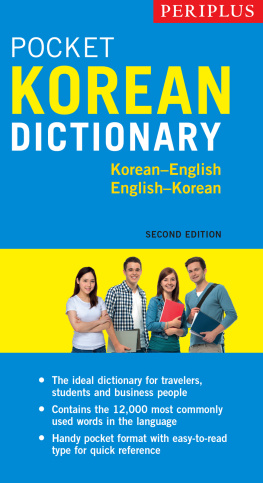
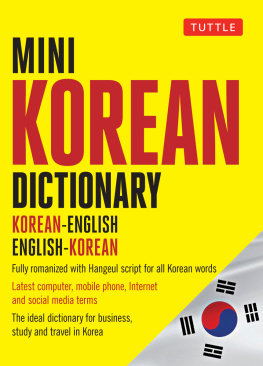

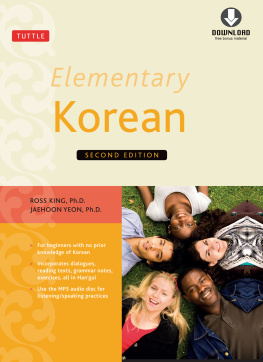
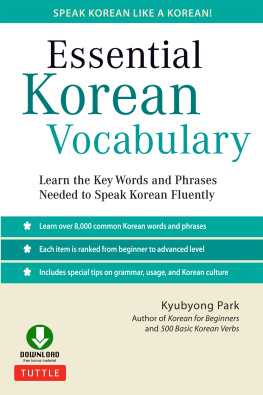
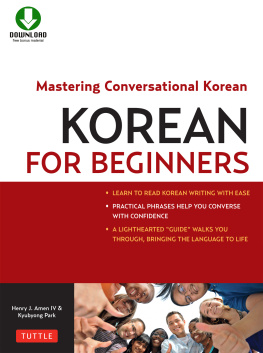
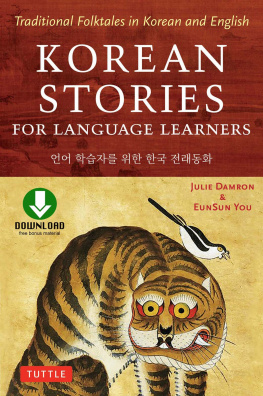


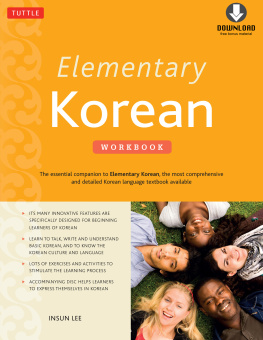
 Written by: Billy Go Edited by: Sohyun Sohn and Patricia Brooks Published by: GO! Billy Korean Audio files for this book are available for free download from gobillykorean.com. Cover and inside illustrations by: HeeJin Park () Copyright 2016 GO! Billy Korean http://www.gobillykorean.com All rights reserved Smashwords Edition, License Notes This ebook is licensed for your personal enjoyment only. This ebook may not be re-sold or given away to other people. If you would like to share this book with another person, please purchase an additional copy for each recipient. If youre reading this book and did not purchase it, or it was not purchased for your use only, then please return to your favorite ebook retailer and purchase your own copy. Thank you for respecting the hard work of this author.
Written by: Billy Go Edited by: Sohyun Sohn and Patricia Brooks Published by: GO! Billy Korean Audio files for this book are available for free download from gobillykorean.com. Cover and inside illustrations by: HeeJin Park () Copyright 2016 GO! Billy Korean http://www.gobillykorean.com All rights reserved Smashwords Edition, License Notes This ebook is licensed for your personal enjoyment only. This ebook may not be re-sold or given away to other people. If you would like to share this book with another person, please purchase an additional copy for each recipient. If youre reading this book and did not purchase it, or it was not purchased for your use only, then please return to your favorite ebook retailer and purchase your own copy. Thank you for respecting the hard work of this author. About this Book While all three books in this series follow the same general format of presenting dialogues with grammar explanations and additional notes, each book offers something unique. The first book, Korean Made Simple, focuses on building the basic foundations to begin studying Korean.
About this Book While all three books in this series follow the same general format of presenting dialogues with grammar explanations and additional notes, each book offers something unique. The first book, Korean Made Simple, focuses on building the basic foundations to begin studying Korean.